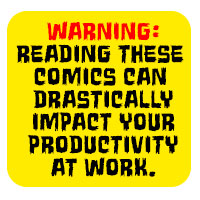Attitude Poses: Barry’s Critique
The first week’s assignment was on creating convincing attitude poses. I received Barry’s submission a few days back. Barry has done a good job of conveying solidity in his drawings – they have volume and take up space. But when the character poses are silhouetted it’s very difficult to readily guess the attitude poses from the drawings. The hands across the arms usually indicates tension or stress – in a front view it may be ambiguous to know what the character’s attitude is. The middle pose shows a hint of the attitude “tired” with the head tilted forward. The pose on the right could possibly suggest anger, but it’s not clear.
In each of the poses, my suggestion for Barry would be to really push the line of action, or through-line, of the character. The line of action corresponds to the character’s spine. The appendages, head, and body should all support the line of action. Another suggestion I have for Barry would be to make the characters a bit off balance. Raise one of the legs – have the character in the air. Avoid pure verticality in the pose – try bending or twisting the characters, while maintaining clarity of the silhouette. A profile view may be better at conveying a character’s attitude than a front view, depending upon the attitude being conveyed.
Below are my interpretations of the three attitude poses. I have drawn the line of action through each character (in red) to highlight its role in the character’s attitude pose. Something else to note. The character’s description is that of being overweight. I have exaggerated the torso (and belly) over the head, on purpose, to support the notion that the character is heavy. Proportions are great way of accentuating a dominant character trait. Smart characters have large heads, tall characters have long legs, etc.
As always, I welcome your questions and comments.
-Krishna





Barry Buchanan
January 10, 2012 at 8:27 pmThanks for the insights. As I suspected I don’t know what I don’t know. I will put what you said to work for me. I need to go draw now.
Jose Gonzalez
January 10, 2012 at 9:14 pmAwesome! Incredible how the line of action, (or a gesture drawing) will do to convey the emotion. I like Barry’s poses. They convey the emotion, and the small details peg it down, like I seem to do too often. But you know… those lines of actions seem to be the heart of it. Also, the advice I hear a lot is: “You got to exaggerate” – at least in animation. Twisting and offsetting a figure does a lot too, but I’ve seen some wildly exaggerated poses out there that just don’t make sense. One has to strike a balance, depending on the final purpose of the piece.
Krishna, your mentees (or apprentices) are in for a lot of fun, judging by what I’ve just seen here. Awesome to witness.
Thanks for letting us in, guys!
Brian
January 10, 2012 at 10:10 pmThe best advice I ever got about attitude and gesture was this, pretend your characters are on stage. They have to OVER-act to sell their emotion. That’s the reason comic book characters are so dynamic. Great work by the mentor and mentoree.
Oskar 'Skar' van Velden
January 11, 2012 at 1:22 pmI just drew my attitude poses, but had such a hard time showing the difference between tired and depressed. I think you can almost not go without the facial expression to show that :P
Rene van Belzen
January 14, 2012 at 8:32 amCould you elaborate what action lines are. I saw the ones you drew on your characters, but I can’t see the connection between the action line and the actual position of the torso, head and limbs. I thought it was the spine, but, after studying your examples, the action line clearly isn’t the spine. So what is it?
Krishna
January 14, 2012 at 8:41 amI think of the line of action as the first, fast, simple mark that conveys the extent and direction of the pose.